Spring Auction Review Part 1: Zito Collection
On April 5, the Paul and Rosalie Zito consignment of just ninety-two coins was auctioned for more than $4.25 million in total. This was a very important offering of fresh material, and a newsworthy assortment of U.S. gold coins was featured.
THE ZITO COLLECTION was one of many consignments in the Stack’s Bowers auction that was connected to a recent coin show in Baltimore, though actually conducted the following week at this firm’s headquarters in Orange County, California. Auction lots were available for viewing at the Stack’s Bowers store in New York and then at the convention center in Baltimore.
The Stack’s Bowers Galleries (SBG) auction in April was highly anticipated and subject to even more attention than usual, mostly because there was a severe shortage of rare U.S. gold coins in the marketplace and the rally for rare U.S. gold coins that began in 2021 was still in force. SBG auctioned a massive number of rare gold coins, including condition rarities of scarce coins. The whole SBG spring auction extravaganza totaled more than $37 million, and most of this total stems from offerings of U.S. gold coins.
It is impossible to fairly cover a large portion of this auction in one discussion. The present topic is the consignment of coins purchased years ago by Paul and Rosalie Zito. The late Paul Zito, MD, was an accomplished surgeon.
Generally in auction coverage, I mention newsworthy items, particularly important coins, especially appealing coins, and some relatively inexpensive coins. Additionally, I aim to shed light upon market trends.
It is true that market levels for rare U.S. gold business strikes continue to rise, by at least 4%, on average, so far in 2022. Auction results, though, must be interpreted with regard to the context of and participation in the respective auction. As this Stack’s Bowers auction contained a great deal of fresh material, and dealer inventories of rare gold coins were so low in early April, coins brought more than corresponding coins with the same respective certifications would have brought in more typical scenarios.
Fresh material tends to bring much stronger prices than coins that have recently been offered in auctions, openly at major shows or on dealer websites. A coin is “fresh” if it has been off the market for more than five years. A coin does not have to be of high quality to be fresh, nor does it have to be relatively original.
On average, fresh coins in PCGS or NGC holders are more likely to be candidates for upgrades than other coins that are offered publicly. Also, fresh coins that have been submitted only once to PCGS or NGC are far more likely, on average, to be candidates for upgrades than similar coins that have been submitted multiple times during the last twenty years.
As far as I know, all of the coins in the Zito Collection were certified by PCGS or NGC before they were purchased by Dr. Paul Zito and/or Rosalie Zito. The coins in the Zito consignment were purchased from 1995 to 2003, and most were in old holders while being auctioned on April 5, 2022.
Though I wish that this were not so, a significant number of the Zito Collection coins are likely to upgrade at PCGS or NGC if they are cracked out of their respective holders and resubmitted. The likelihood of particular coins upgrading must be factored into a sound analysis of prices realized in an auction of a collection of fresh, classic U.S. coins.
A rare U.S. coin that is upgraded from 64 to 65 or from 65 to 66 magically increases in value to a large extent while it is being re-encapsulated, although it is the same coin as it was the moment before it was upgraded. Is this entirely fair to the collector who buys a rare coin after it has been upgraded?
Even if it is never doctored, a coin that is repeatedly resubmitted may end up with a grade that is higher than most pertinent experts would assign to it. I am commenting here on the consequences of upgrades more so than usual because perceived prospects for upgrades substantially affected the results of the Zito, Fairmont and Rarities Night sessions of this SBG auction. In a case where the successful bidder has no intention of seeking an upgrade, the underbidder may have had such an intention or another leading bidder may have been driven by a coin’s perceived upgrade potential.
While the coins in the Zito consignment had been on the market before, they were exceptionally fresh. If a large number of rare gold coins from the Fairmont hoard had not been in this same auction extravaganza, more dealers and collectors would have been talking about the freshness of the Zito consignment. There were important fresh coins in the Rarities Night session, too.
Although many pieces in the Zito session and some coins in the Rarities Night sessions were strong candidates for upgrades, most were not candidates and many prices realized provide circumstantial evidence regarding market realities. The owners of the Zito Collection benefited by selling in April 2022. It is unclear to me as to whether the Zito consignment was a traditional collection or some kind of speculative portfolio.
While there were many rarities and choice type coins, most do not seem to be in any kind of order. Furthermore, the Paul and Rosalie Zito Collection had an assortment of common coins, which did not seem to be parts of sets, including four PCGS graded MS63 1893 half eagles (U.S. $5 gold coins). Would a true collection of less than one hundred U.S. coins really include four 1893 half eagles? Also, the three 1901-S eagles ($10 gold coins), the most common Liberty Head eagle, seem inconsistent with a “collection” that features many rare gold coins.
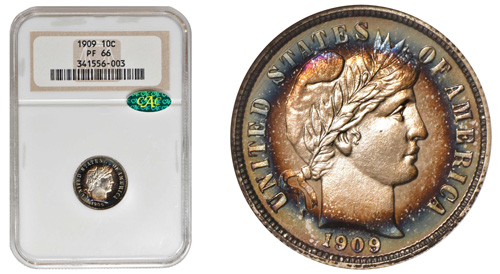
The eighty-eight lots in the Zito consignment consisted of ninety-two coins, eighty-two of which were gold. Most of the Zito Collection gold coins were minted after 1870. An 1886 gold Proof set was featured. The Zito session included twelve coins relating to the year 1909, including a five piece non-gold 1909 Proof set and two 1909-D Indian Head half eagles.
Their 1909-S VDB Lincoln cent was NGC graded as MS65 with a Red-Brown designation and received a sticker of approval from CAC. The $4,320 result was consistent with recent prices realized for certified MS65RB 1909-S VDB Lincolns. The result was thus not a piece of evidence that market levels for these have been increasing.
Though not exemplary, the Zito Collection 1909 Proof set was appealing. I liked the three Barber coins: dime, quarter and half. These were all NGC certified as Proof-66, with CAC stickers. The relatively light centers contrasted well with natural tones, featuring colors that are often seen on Proof silver coins from the era.
I was puzzled by the $10,200 auction result for this 1909 Proof set. I really did not figure the quarter or the half dollar as being likely to upgrade to 67. The CPG® retail price estimates for the components are relevant; half: $3,380, quarter: $2,060, dime: $910, nickel: $822 and cent: $1,620, for a total of $8,792. These CPG® values are not underestimates. Indeed, corresponding, recent auction results for individual 1909 Proof silver coins have been much lower than CPG ® retail estimates and sometimes lower than corresponding Greysheet Bids.
It is pertinent that one or more of the Barber coins could upgrade just by receiving a Cameo designation. A certified Proof-66 Cameo 1909 Barber half is worth substantially more than a certified Proof-66 1909 half without a Cameo designation. Nonetheless, it is hard to believe that prospects for Cameo designations would justify a dealer paying an amount even close to $10,200 for this Proof set.
I did not closely inspect the dime. If, however, it is imagined that this 1909 dime upgrades from Proof-66 to Proof-67 Cameo, then the $10,200 result might be profitable for a dealer-buyer, especially if at least one one other coin received a Cameo designation, a plus or even a whole number upgrade.
Also, cameo contrasts are sometimes enhanced via dipping or other means. Such modifications are harmful, in my personal opinion.
Another possibility is that this realization is just an example of the success of this particular auction. Two enthusiastic collectors may just have competed fiercely for this set. An analysis of reasons for the price realized is beside the fact that the $10,200 result is very much newsworthy for a Proof set that would otherwise have attracted little notice. Pre-1917 Proof sets do not now command nearly as much attention as they received from collectors during the second half of the 20th century.
Currently, in coin auctions in general, in advertising campaigns and in the media, double eagles (U.S. $20 gold coins) receive a disproportionate share of attention. Eagles ($10 gold coins) receive a lot of attention, too. One Dollar and $2-1/2 gold pieces (quarter eagles) are not covered nearly as often.
The CAC-approved, NGC graded MS67 1889 One Dollar gold piece in the Zito consignment brought a strong price, $5,040. The Greysheet-CAC Bid was $3,600 and the CPG®-CAC medium retail price estimate was $4,500. Although in an old holder, and a technically impressive coin, this 1889 does not have enough eye appeal to merit an upgrade to MS68, in my view.
The 1889 is one of the three most common One Dollar gold pieces. Furthermore, PCGS and NGC have certified hundreds of them as MS67 and quite a few as MS68. CAC reports eighty-nine as MS67, some of which are superior to this one. The $5,040 auction result may be a little above a recent value trend line over time for CAC approved MS67 grade, 1889 One Dollar gold pieces. Generally, though, these rose in value last year by more than 15% and probably increased by another 2% or 3% so far in 2022.
A collector need not be super-rich to afford the Zito NGC-graded MS63 1901 quarter eagle, with a CAC sticker, which brought $660, or the CAC approved, PCGS graded MS64 1902 quarter eagle, which brought $1,080! These were both very appealing coins in old holders.
Although collectors will enjoy owning some of the nice, relatively inexpensive gold coins in the Zito session, the stars of the Zito Collection were expensive, especially the 1907 Wire Edge and Rolled Edge eagles, both popular and important rarities. As Wire Edge and Rolled Edge tens were unusual products with distinctive finishes that were minted only in 1907, a reference to a Wire Edge or a Rolled Edge ten can only refer to an eagle dated 1907 so there is no need to repeat the year 1907 over and over again.
Long ago, these were regarded as patterns. U.S. Mint records, however, have since been interpreted to mean that both Wire Edge and Rolled Edge eagles are true coins, though I maintain that their status should be reexamined. Nevertheless, it is indisputable that collectors currently demand them for sets of Indian Head eagles.
The primary components of the values of Wire Edge and Rolled Edge tens relate to their perceived status as type coins. Strangely, type sets in the PCGS registry, which include or feature 20th century gold coins, require both a Rolled Edge and a Wire Edge in addition to a 1907 or 1908 No Motto, No Periods eagle. Although NGC registry sets do not have this requirement, the notion that Rolled Edge and Wire Edge tens are both required for any relevant type set and for sets by date of eagles has become part of the culture of coin collecting. Consequently, these are very expensive, though the prices realized for the Zito Collection Rolled Edge and Wire Edge tens certainly startled some collectors and dealers.
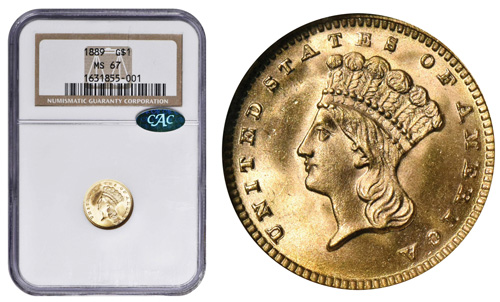
Price guides and past auction results may have caused some analysts to figure that the $840,000 result for the Zito consignment, 1907 Wire Edge eagle was super strong, perhaps astronomically high. To a collector who feels compelled to complete a true gem quality set that requires a Wire Edge eagle, however, the $840,000 result should not be thought of as being all that high.
The Zito Collection Wire Edge ten was NGC graded as MS68. On August 14, 2019, Heritage auctioned a different NGC graded MS68 Wire Edge ten for $432,000. This would be a misleading comparison, however, because the Zito coin is relatively more original and is much better overall than the coin that realized $432,000 in 2019. The Wire Edge ten that sold for $432,000 in August 2019 probably would have realized a price in the $500,000 to $700,000 range had it been auctioned in April 2022.
Especially for MS65 to MS68 Wire Edge tens, certified grades should not be taken too seriously. To understand highly certified Wire Edge eagles, there is a need to focus intently on the precise physical characteristics of the individual coins.
On March 20, 2020, in the Pogue VII sale, SBG auctioned a PCGS graded MS67 Wire Edge ten for $240,000, which was a strong price for that specific coin. In the present, if I imagine that I was advising a non-investing collector who had his heart set on a gem set of Indian Head eagles, including unusual strikings, I would assert that it would be preferable to pay $840,000 for the Zito coin than to pay $240,000 for the Pogue Collection Wire Edge ten. The differences between these two coins are not insignificant.
In July 2013, SBG auctioned the Bentley Shores Collection, in which a PCGS graded MS67 1907 Wire Edge ten sold for $211,500. That was not an appealing coin for its assigned grade. The presently discussed Zito coin is vastly superior. Indeed, the Zito Wire Edge ten is technically amazing.
Wire Edge tens often have annoying contact marks, light scratches and deliberate additives. If the Zito coin was in a lineup of all the certified MS66 to MS68 Wire Edge tens that I have seen during the last ten years, the Zito coin would be, by far, the most appealing to me.
It is true that the Zito Collection Wire Edge ten does not have a CAC sticker. There are no Wire Edge or Rolled Edge tens that have been CAC approved at the MS68 level. If, hypothetically, the Zito Wire Edge eagle was downgraded to MS67+ and submitted to CAC, it is extremely likely that it would receive a sticker.
Rolled Edge eagles are much rarer than Wire Edge eagles, and are very different in texture. The Zito Collection Rolled Edge ten features rich orange hues, which are complemented by blue tints and other colors, truly an extremely attractive coin.
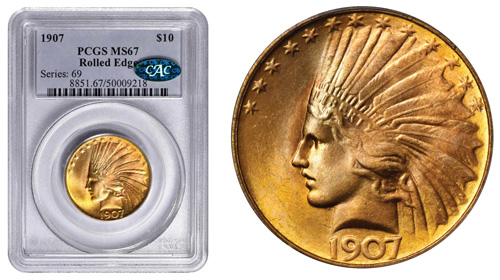
The Zito 1907 Rolled Edge ten is one of only three that PCGS has graded as MS67 and PCGS has graded one as MS67+, though none above MS67+. Experts at CAC ignore the plus aspect of plus grades assigned by PCGS or NGC. This Zito coin is one of only two 1907 Rolled Edge tens that have been CAC approved in the MS67 range, and are thus at the top of the CAC pop.
The PCGS graded MS67+ Rolled Edge eagle is in the Simpson Collection. Sources suggest that the Simpson coin may have never been sent to CAC.
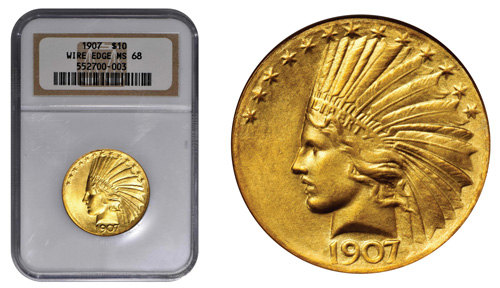
The other CAC approved, PCGS graded MS67 Rolled Edge ten is the Pogue Collection coin, which SBG auctioned on March 20, 2020, for $576,000. In my view, the Zito coin is clearly superior to the Pogue Rolled Edge ten. If it is imagined that the Pogue Collection Rolled Edge ten was in this same SBG auction in April 2022, it probably would have realized a price in the $700,000 to $805,000 range, 20% to 40% more than the $576,000 price that the Pogue Rolled Edge realized in March 2020.
The Zito Rolled Edge realized $1,140,000 on April 5, 2022. Though I will remember this specific coin for years, the curious mix of important rarities and very common gold coins in the Zito Collection was memorable as well.
Copyright ©2022 Greg Reynolds
Insightful10@gmail.com
Images courtesy of Stack's Bowers Galleries.

Download the Greysheet app for access to pricing, news, events and your subscriptions.
Subscribe Now.

Subscribe to The Greysheet for the industry's most respected pricing and to read more articles just like this.
Source: Greg Reynolds
Related Stories (powered by Greysheet News)
View all news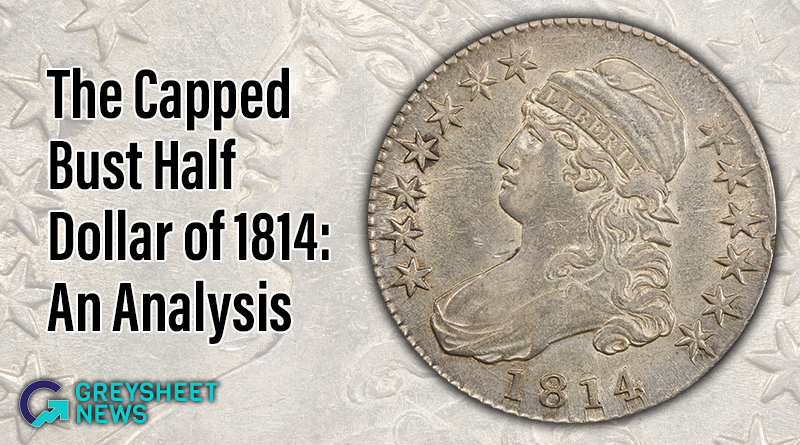
In this article Greg Reynolds analyzes the 1814 Capped Bust Half Dollar.
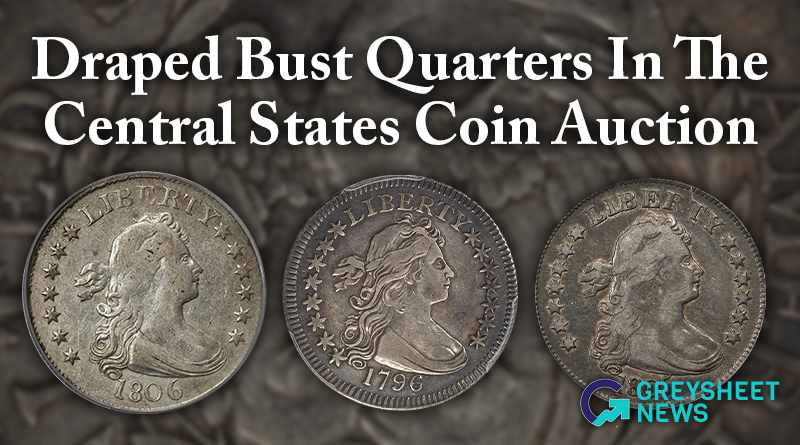
The Lusk set of Draped Bust quarters brought strong results.
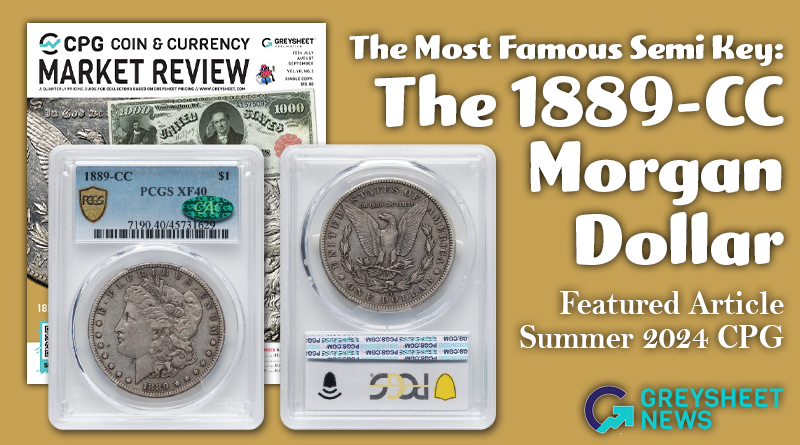
The 1889-CC is the second scarcest business strike in the series.


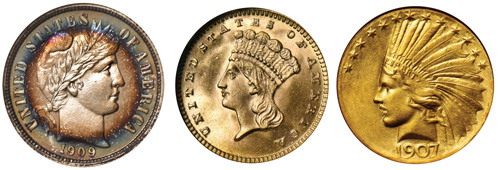






Please sign in or register to leave a comment.
Your identity will be restricted to first name/last initial, or a user ID you create.
Comment
Comments